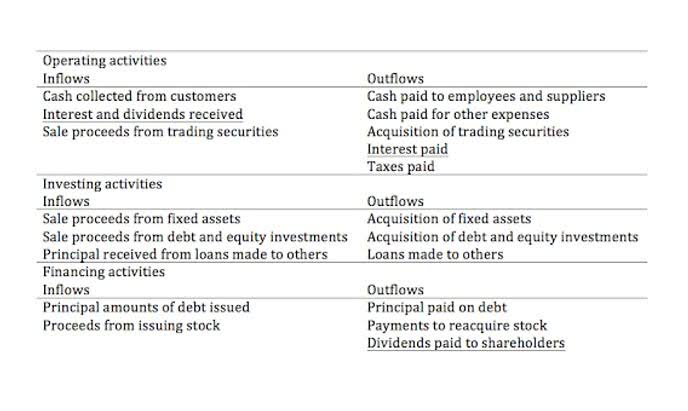Cash Flow Statement Example Template How to Prepare Explanation

Gain real-time insights into cash positions for accurate analysis and decision-making. So one would look over the bank T-account and possibly the cash receipts journal and cash payments journal (if needed). Similarly, drawings (or dividends for a corporation) may also be placed under this section, although it can also be placed under the operating activities section if the business so chooses.

What Is Direct And Indirect Method Of Cash Flows Statement?

The reason is that by decreasing its inventory the company avoided purchasing $700 of the cost of goods sold that reduced net income. Not having to pay $700 of the cost of goods sold was good/positive for the company’s cash balance. Amounts without parentheses indicate a positive effect on the contra asset account company’s cash balance. An amount without parentheses can also be viewed as a cash inflow or cash provided.

Who Uses Cash Flow Statements?
- An example cash flow statement is also included to help guide you through the process.
- The statement of cash flow analysis prepared through an indirect method requires adjustment of the non-cash items which are earned but not yet received.
- Under this method the starting point is the net income reported on the income statement.
- Besides, statement of cash flow equation also classifies business activities into operational, investing, and financing activities.
- The indirect method reports the operating cash flows by beginning with the net income from your income statement.
During the two-month time period, the company’s inventory changed from $0 on January 1 to $200 at February 29. The use of cash for adding goods to inventory is also viewed as not good for the company’s cash balance and is therefore reported on the SCF as (200). The proceeds (cash received) from the sale of long-term investments are reported as positive amounts since the proceeds are favorable Accounting for Marketing Agencies for the company’s cash balance. In the long run, having a positive cash flow to read a income statement certainly is an indicator of a profitable business. Essentially, the accountant will convert net income to actual cash flow by de-accruing it through a process of identifying any non-cash expenses for the period from the income statement.
- The net income line items are also adjusted for changes in the ending and starting balances of current assets, with the exception of cash.
- From annual filings to corporate governance, we’ll keep your company compliant and running smoothly.
- Mastering the complexities of cash flow statements empowers both businesses and investors to make well-informed decisions, laying the foundation for a resilient and sustainable financial future.
- In real life this extreme situation would rarely occur, but this example serves to explain that the cash situation of a business is key.
- (The calculation is $300 cash inflow – $800 cash outflow – $200 cash outflow.) The net cash outflow is presented as a negative amount and is described as net cash used in operating activities.
- The concluding segment of the statement reveals the net cash flow, which adds up the operating, investing, and financing flows.
Why Do Businesses Need Cash Flow Statements?

Note that the combination of the positive and negative amounts in this section add up to a positive 262,000. If the amounts had added up to a negative amount, the description would be “Net cash used by operating activities”. Lastly, at the bottom of all financial statements is a sentence that informs the reader to read the notes to the financial statements. The reason is that not all business transactions can be adequately expressed as amounts on the face of the financial statements. Remember to regularly monitor and forecast your cash flow, control expenses, and explore financing options to ensure the financial stability and success of your business. The result is the business ended the year with a positive cash flow of $3.5 billion, and total cash of $14.26 billion.
- Since the net income was determined through the accrual basis of accounting, we will list the adjustments needed to convert the amount of net income to the net cash provided (used) by operating activities.
- Therefore, the company shows a positive $500 on its SCF as an adjustment to the net income amount.
- While the cash flow statement is a critical part of financial reporting, it serves a distinct purpose compared to the income statement or the balance sheet.
- Businesses can choose between direct and indirect methods for cash flow calculation.
- A Statement of Cash Flow is an accounting document that tracks the incoming and outgoing cash and cash equivalents from a business.
- To give you a head start in preparing a cash flow statement, we’ve created 3 different statement templates, including monthly, quarterly, and annual formats.

It also enables stakeholders like investors, shareholders, and creditors to assess the extent of risk and return expected from a business. A Statement of Cash Flow is an accounting document that tracks the incoming and outgoing cash and cash equivalents from a business. It helps identify the availability of liquid funds with the organization in a particular accounting period.
Debt Collection Letter Templates for Every Stage
- A balance sheet must always “balance,” meaning assets minus liabilities must always equal shareholder equity.
- If you’re a manager, it can help you more effectively manage budgets, oversee your team, and develop closer relationships with leadership—ultimately allowing you to play a larger role within your organization.
- Accrual accounting relies on balance sheets and income statements, determining cash flow by using net income a defined on the income statement and working backwards to adjust for non-cash transactions.
- Here’s an example of the direct cash flow statement for the sample company ABC Corporation.
This is important because cash flow is about timing – making sure you have money on hand cash flow statement example when you need it to pay expenses, buy inventory and other assets, and pay your employees. Cash flow and working capital are both essential metrics but serve different purposes in financial management. Cash flow refers to the movement of money in and out of the business, reflecting liquidity over a specific period. In contrast, working capital measures current assets minus current liabilities, providing a snapshot of short-term financial health. While cash flow focuses on how money moves, working capital emphasizes available resources for day-to-day operations.

Leave a Reply
Want to join the discussion?Feel free to contribute!